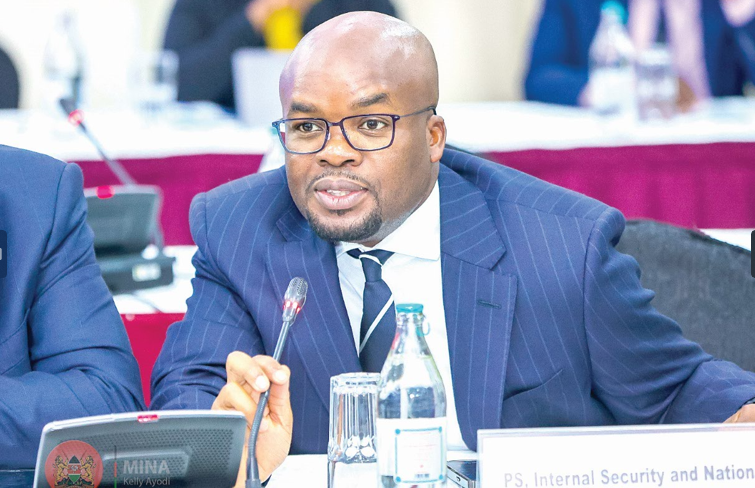Fighting to give fistula patients dignity

Eighteen-year-old Mary Nafula Simiyu remembers the gruesome ordeal subjected to her by a man nearly eight years ago and the consequences of being raped as if it was just yesterday.
The Class Four pupil at the time was alone at home when a strange man appeared from nowhere and raped her. She did not recognise him.
“A few days after the fateful day, I started passing urine uncontrollably and I also had a strong and bad smell that came with the leaking,” she recounts
At that point, Mary dropped out of school as she had difficulty walking and her smell put off her classmates.
She was later diagnosed with obstetric fistula and a corrective surgery was done with the help of Fistula Foundation. Now fully recovered, Mary is determeined to pursue her education.
She becomes emotional about the day she received surgery and later got the support of Women and Development Against Distress in Africa (WADADIA) to continue with her secondary school education.
“Women and girls with fistula are both physically emotionally and economically affected. The condition leads to families breaking up, loss of employment, school dropouts, mental health issues, including anxiety and depression,” says Habiba Mohamed, Fistula Foundation Kenya country director and WADADIA founder.
It is for this reason that they have a comprehensive reintegration programme that addresses most of the fistula survivors’ psychosocial issues to ensure they attain holistic recovery.
Mary represents one of many women burdened with silent suffering, enduring stigma within their communities, and grappling with the harsh reality of being marginalized due to the foul smell of leaked urine and stool.
She describes Mary as bold for opening up about her condition, unlike majority of women who would rather suffer in silence.
“It’s important for patients to come out and share their story with this condition in order to debunk the many myths and misconceptions associated with it, women with fistula rarely come out to seek services on their own,” she explains.
She says it takes time and resources to reach patients at the household level and to convince them that they have a medical condition that is both treatable and preventable.
Obstetric fistula is a childbirth injury that occurs when a woman has prolonged, obstructed labour, but is unable to access emergency obstetric care. As a result, the woman develops a hole between her vagina and her bladder or rectum. Mary’s story is ‘typical’, fistula nurse Andrew Kelvin Rutto says.
In Kenya, it is estimated that 3,000 new fistula cases are recorded every year with approximately one to two fistulae for every 1,000 deliveries. At least one million women suffering needlessly from these devastating conditions across sub-Saharan Africa and Asia.
“The true figure is, however, not known because people do not come out, they are stigmatised as a result,” says Kelvin, adding, “So what we see is probably the tip of the iceberg.”
He also sheds light on perineal tears, which is another type of childbirth injury, similar to fistula, and which he points out has become common. If left untreated, a fistula or perennial tear will cause a woman to leak urine, stool, or both for the rest of her life.
Dr Daisy Ruto who has been at the helm of Obstetric Fistula at Johns Hopkins Programme for International Education in Gynecology and Obstetrics (Jhpiego) Kenya, notes some of the women have been shunned and so stigmatised that they have lost social skills.
“They need a counsellor to work on their mental health and support their integration back into society,” says Dr Ruto. Habiba lists 10 counties that lead in the number of fistula cases as Bungoma, Narok,
Homabay, Uasin Gishu, Tranzoia, Kakamega, West Pokot, Kisii, Garisa, and Kisumu counties.
“The order of which county leads in the cases keeps changing almost every two years, demostrating that the number of cases seen in a region is a reflection of the level of investment and interventions and not necessarily an indication of fistula prevalence,” she explains.
On the International Day to End Obstetric Fistula marked recently, Fistula Foundation engaged in a series of sensitisation events in their respective communities, this climaxed with public events, fistula screening exercises and routine treatment.
Dr Ruto describes obstetric fistula as a severe maternal morbidity, which can affect any woman or girl who suffers from prolonged or obstructed labour without timely access to an emergency Caesarean Section.
It is one of the most devastating consequences of neglected childbirth and a stark example of health inequity in the world.
Although the condition has been eliminated in industrialised countries, it continues to afflict the most impoverished women and girls in the developing world, mainly those in rural and remote areas.
Corrective surgeries are the only treatment to cure the incontinence that a fistula causes.
Nearly 2,500 seek care annually and only three in 10 get the surgery resulting in a backlog, partly due to a lack of trained surgeons.
Kenya grapples with an incredibly low number of surgeons who have the required training to carry out fistula repairs. Currently there are only 10 trained surgeons with specialised skills for fistula repair.
“Despite it being preventable and treatable, only 1,000 fistula surgeries (less than half of the cases) are done in Kenya yearly,” says Pumwani Hospital-based Dr Kamau Kinya.
With the increased cost of living, only 7.5 per cent of the girls and women can access fistula-related medical care, including surgery, at around Sh7,000.
“It is a lot of money,” he concedes, adding that in Kenya the expense is mainly catered for by the United Nations Population Fund (UNFPA).
UNFPA leads the global Campaign to End Fistula, a drive to transform the lives of vulnerable women and girls.
The 20-year-old campaign represents a global commitment to fistula prevention and holistic treatment, including surgical repair and social reintegration and rehabilitation.
Despite progress, elimination by 2030 demands accelerated action. To that end, the theme for the International day this year was “20 years on – progress, but not enough! Act now to end fistula by 2030!”
Furthermore, less than 10 per cent of health facilities in the country can offer basic emergency obstetric care and only six per cent comprehensive emergency obstetric care.
The ‘Fistula Belt’ is, therefore, synonymous with counties with high levels of poverty, insufficient infrastructure, lack of specialised workforce, poor referral networks and over-reliance on donor support.
Women and girls hence live with the debilitating experiences of constant leaking of urine and/or faeces and the indignity of severe stigma and isolation.“Fistula, an injury caused by long, painful obstructed labour and the leading cause of disability during childbirth, calls for a multi-pronged approach,” notes Dr Kamau.
That entails strengthening primary health care, expansion of fistula treatment networks and post-repair support through multi-sectoral partnership, political goodwill and action for the patients.
To address maternal deaths and continued suffering of the affected, the government has put in place strategies, policies and guidelines aimed at ending fistula by 2030. With the devolution of health functions, therefore, the implementation of these policies lies squarely on the shoulders of the county leadership.
Studies show regional fistula treatment networks are effective in increasing awareness and access to fistula care services, reducing stigma and enhancing post-operative follow-up and reintegration support.
But such networks only thrive in the backdrop of solid implementation frameworks that strengthen a people-centred approach to healthcare.












